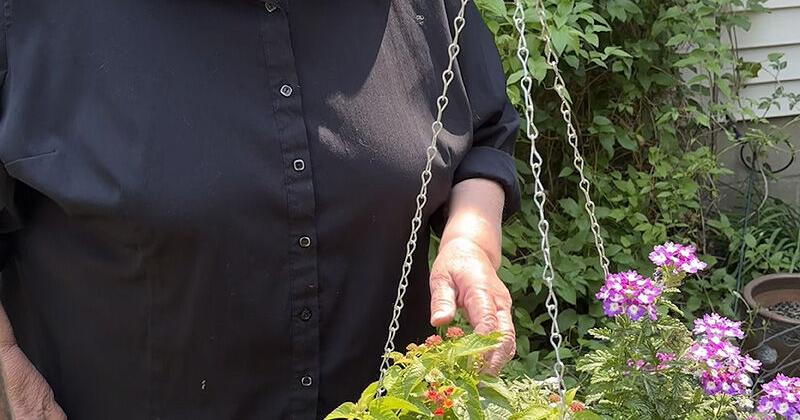Joyce Wilcox would say her interest in gardening is innate. She grew up one of nine children on a hog and chicken farm between Wells and Waldorf, Minn. The mentality was, Wilcox explained, if they didn’t grow it, they didn’t eat it. She started gardening with her mother at the age of eight or nine.
Her mother didn’t have formal training in gardening, but naturally knew how to raise vegetables. Wilcox, in turn, soaked up that knowledge.
“I’ve always had a love for flowers,” Wilcox added, though that was an area of expertise she had to gain another way. Being from the Depression era, her mother didn’t see them as particularly useful. Wilcox understands she could, too, do without the blooms, though she added our pollinators cannot — a topic she noted that has become more of a conversation piece in the last decade.
“That’s one of our missions as Master Gardeners is to try to educate and promote the use of pollinator plants in your gardens and your yards,” Wilcox stated.
Wilcox has been a Master Gardener through the University of Minnesota Extension since 2005. She knew about the program for years prior, but was working full-time as a food service professional. In order to take the 40-hour course, she took a week of vacation from her job.
During a Master Gardener’s first year, they are required to complete 50 hours of volunteer work related to the position. Each year after requires 25 hours of volunteering, as well as 5 hours of continuing education.
Master Gardeners provide education in a number of ways. Every April, they host their Spring Alive education event — free and open to the public. Wilcox stated some gardeners have worked with Habitat for Humanity to provide information about what plants would grow well at specific locations, as well as plants requiring easier maintenance. The gardeners have also attended events at the Children’s Museum of Southern Minnesota, giving information about pollinator plants and butterflies.
Wilcox shares her gardening knowledge for the KTOE radio station’s Talk of the Town show, and has been doing so for a number of years — at least 15, she estimated. She also chimes in on their Saturday morning Garden Talk segment. Listeners are able to ask questions ahead of time to which Wilcox will then respond on air. While she’s learned a lot over the years, she is still sure to confirm her own understanding with research. “I always want to make sure that the information I’m giving people comes from various sources,” she stated. “I want to know I’m right.”
Wilcox also gives presentations to the Mankato Area Lifelong Learners. The topics vary; she has detailed how to create a hanging flower basket as opposed to paying significantly more for a pre-made one. The cardinal rule, she explained, is to include three categories of plants: a thriller, a filler, and a spiller.
An area that she shared is worth investing a little more money is gardening soil. Wilcox explained soil should have an even mix of nitrogen, phosphorus, and potassium, and so it’s important for a gardener to know what they’re working with in order to make the needed adjustments. “One thing we really encourage people to do, and you can do this through the Extension service, is have a soil test,” she stated.
Wilcox noted a big yard isn’t necessary to garden. “You can have one honeysuckle bush and the hummingbirds will be lined up,” she stated. A tomato plant can be grown on an apartment balcony. Wilcox did note individuals need to be mindful of their surroundings. For example, while she has ample yard space, she continues to grow vegetables on her family’s farm due to a black walnut tree on their property. The juglone produced by the tree inhibits the growth of vegetables in the nightshade family (peppers, tomatoes, potatoes, etc), which are the primary vegetables she grows.
She acknowledged the shade from the black walnut does help in home cooling costs, though the tree also brings a number of squirrels with an affinity for digging in flower pots. Utilizing hardware cloth and chicken wire has helped with mitigation, though, with a laugh, she stated the ongoing battle is never easy.
The topic of weather naturally comes up in conversation, notably how gardening has been impacted by the changes in weather. Two years ago, the majority of Blue Earth County’s plant hardiness zone changed from 4b to 5a. Wilcox stated, “Our seasons have really dramatically changed a lot. The one big change that I’ve seen is springs are late and cooler and I would say even wetter, and our falls are really long and dry.”
Last fall, Wilcox stated she went on a trip at the end of October. Upon her return on November 4, she picked a bouquet of annuals that were still blooming in the garden.
With continued changes, Wilcox finds herself researching something at least once a day. While her lilacs haven’t bloomed twice like some have recently experienced, at the end of last summer the lilac bushes throughout her neighborhood had leaves turn black and fall off — a situation she had not witnessed before. It turned out that a bacteria had developed in the soil due to how wet the conditions were followed by how dry it became. This year, her lilac bush and the others in the area were back to blooming.
The Master Gardeners hold an annual plant sale the Saturday after Mother’s Day and also have informational tables at garden centers and other locations throughout the year. The group has a strong presence at the Blue Earth County Fair, which will run July 24–27 this year. The gardeners help in the horticulture building, assist with 4-H judging, and complete groundswork.
For gardening topics from the University of Minnesota Extension, visit extension.umn.edu/fruit-and-vegetable-farming. Information about the Master Gardener program is at extension.umn.edu/master-gardener/about-master-gardener. The Blue Earth County Master Gardeners can be found on at facebook.com/MasterGardenersofMNRiverValley.

